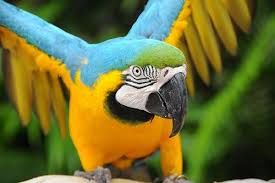Blue-and-Gold Macaw

Description
The blue-and-yellow macaw (Ara ararauna), also known as the blue-and-gold macaw, is a large South American parrot with blue top parts and yellow under parts. It is a member of the large group of neotropical parrots known as macaws. It inhabits forest (especially varzea, but also in open sections of terra firme or unflooded forest), woodland and savannah of tropical South America. They are popular in aviculture because of their striking color, ability to talk, ready availability in the marketplace, and close bonding to humans.
These birds can reach a length of 76–86 cm (30–34 in) and weigh 0.900–1.5 kg (2–3 lb), making them some of the larger members of their family. They are vivid in appearance with blue-green wings and tail, dark-blue chin, golden under parts, and a green forehead. Their beaks are black. The naked face is white, turning pink in excited birds, and lined with small, black feathers. Blue-and-yellow macaws live from 30 to 35 years in the wild and reach sexual maturity between the ages of 3 and 6 years.
Little variation in plumage is seen across the range. Some birds have a more orange or "butterscotch" underside color, particularly on the breast. This was often seen in Trinidad birds and others of the Caribbean area. The blue-and-yellow macaw uses its powerful beak for breaking nutshells, and for climbing up and hanging from trees.
Scientific Name
Ara ararauna
Country Of Origin
South America
Size
Large, up to 33 inches
Life Expectancy
60 years average, up to 80 years
Noise Level
Loud
Talk / Trick Ability
Very Good
Characteristics
The well-known blue-and-gold macaw enjoys plenty of attention, head scratching and cuddling, but also likes to play and chew, so provide it colorful hard wooden blocks to destroy. They need lots of room to stretch their wings, so the largest possible is ideal. Blue-and-gold macaws are sociable, easy-going birds that are affectionate and tolerant creatures.
Behavior / Health Concerns
As with all macaws, blue-and-gold macaws are big and will sometimes play rough and enjoy screaming, but love attention and training can reduce biting and other problem behavior. If their nipping is not properly dealt with the bad biting habit can develop into a potential problem. With enough interactive time with those in the household, this macaw’s nippiness and moods can be solved. As a baby, the blue-and-gold macaw are larger than most parrots, and need patience and understanding during their development. Blue-and-gold macaws require more fat in their diet than other parrots, which you can provide with pellet-based diet, fresh fruits, vegetables, whole grains and the occasional nut. They are prolific chewers, so offer toys to chew and destroy often. They are susceptible to overgrown beaks, papillomas, proventricular dilatation disease (PDD, also known as “macaw wasting” disease), psittacosis and vitamin-A sensitivity.
Expert Advice
“Rowdy, loving, intelligent and LOUD.”
Liz Wilson, CVT, CPBC
“Make great pets, but must be worked with daily to keep them from becoming overbearing little brats! Good talkers. Medically, only species documented to have inhalant allergies often due to other bird’s down and dust, especially cockatoos. With proper cared and good nutrition, these birds can live long lives. Obesity is not uncommon on seed diets.”
Samuel Vaughn, DVM, Dip. ABVP – Avian Practice